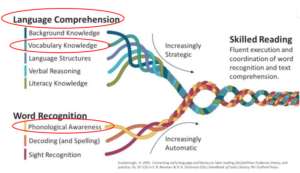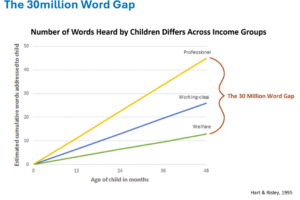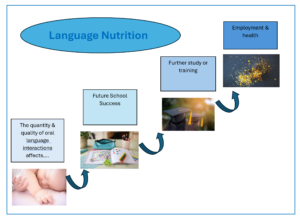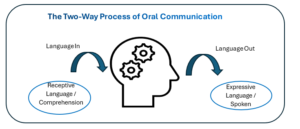Oral Language and Vocabulary….the perfect partners!
Of all the oral language skills, vocabulary knowledge is the
strongest predictor of later reading comprehension ability.
(Lervag et al., 2017; Muter et al., 2004; Ricketts et al., 2007; Roth et al., 2002; Spencer et al., 2014)

Vocabulary acquisition plays a fundamental role in reading comprehension. Research has supported explicit, systematic and cumulative instruction of vocabulary. Storch & Whitehurst, (2002), stressed the importance of including vocabulary instruction in the early years of school. They stated that,
“We must not wait until children have solved the decoding puzzle to begin instruction in oral language skills, such as vocabulary and syntax. These oral language skills should be an integral part of reading instruction beginning in preschool and throughout elementary school.”
The National Reading Panel (2000) identified Vocabulary as one of the “5 Pillars ” essential to reading instruction. Vocabulary appears in the Australian Curriculum in multiple locations, including the content descriptors from Foundation to Year 6, and the emphasis on instruction increases with each year. It is through quality oral language experiences in the early years that a child’s vocabulary begins to develop.

Listen to Dr Brenda Fitzgerald discuss the importance of ‘Oral Language’, the development of the brain, and its impact on reading and further learning throughout life. Stop video at 14.49
(Ted Talks U Tube)
Improving early child development with words: Dr. Brenda Fitzgerald at TEDxAtlanta
Children enter school with varied levels of oral language development. Their vocabulary and has been influenced by different exposure levels to language. This has a critical and profound impact on their future. If students have not developed the skills to read at level by third grade, then they may never catch up and are 4 to 6 times more likely to not graduate from high school.
The development of oral language through high quality social interactions from infancy onwards has a direct impact of a child’s ability to effectively communicate through reading and writing.
For further information regarding the 30million Word Gap and Language Nutrition I have attached the following links to clips and articles
Understanding Hart & Risley’s 30 million word gap research | 20 years later
https://usareads.org/the-thirty-million-word gap/#:~:text=In%20this%20groundbreaking%20study%2C%20

Language Nutrition
Language Nutrition is the term used to describe the linguist input children receive from their environment. Exposure to oral language from birth, that is rich in quality and quantity and delivered through social interactions is critical to a child’s development and is strongly tied to their future literacy, academic success and health.
Early exposure to rich language environment from infancy onwards significantly impacts brain development, language acquisition and cognitive skills. Language nutrition strengthens neural pathways that are required for language processing, comprehension and expression. These interactions include conversations, storytelling, singing, and exposure to languages. It also lays the pathway for effective communication and literacy skills required for later life i.e. acquisition of vocabulary, grammar, syntax, and phonological awareness (Zauche et al. 2017).
Reference
Zauche et al. 2017, The Power of Language Nutrition for Children’s Brain Development, Health, and Future Academic Achievement, Journal of Paediatric Health, Vol.31, No.4.p494. www.jpedhc.ord

Oral language
Oral language is the foundation for the development of literacy skills and is considered to be a strong indicator of later academic achievement (Bradfield et al., 2013; Gross, 2013; Resnick & Snow, 2009).
Oral language is the words and word combinations used to express and comprehend knowledge, ideas, and feelings. It allows us to connect words to communicate and understand. Oral language is the foundation on which all early and later literacy is built (Cadbury and Douglas, 2019). Strong oral language skills are crucial to successfully communicating ideas, needs and goals, and to developing personal relationships.

Oral Communication is a two-way process, which involves speaking and listening.
The core components of language are phonology (rules governing speech sounds), morphology (rules for word building), syntax (rules for combining words together), and semantics language meaning). A student’s vocabulary is the words that they know, understand, and can use in speech and writing. It is part of the semantic system of oral language. (Excerpt from Vocabulary and Oral Language, Five from Five, 2025).
So how do we support our students and their families to ensure that the children are being exposed to oral language, and what high quality strategies and rich vocabulary instruction should we include to support our students in our classrooms?
Children brains are inherently receptive to learning to speak and understand language. Through exposure to language, children develop their Oral (spoken) Word Lexicon. This is a mental dictionary that contains representations of words, their sounds, meanings, and in what context they can be used. A student’s oral word lexicon is essential to spoken language production and comprehension.
Whilst they will naturally learn to communicate through speech if given the right environment, schools have a vital role in building and expanding these basic skills to further support their academic and social development.
Teachers as literacy leaders, must strategically plan for and provide varied opportunities and routines for oral language development in the classroom. It is through these planned opportunities that more sophisticated language can be explicitly introduced and practiced. Words can be unpacked, and the morphological and etymological elements can be introduced to further deepen the learners understanding of how a word may be pronounced, spelled and used in a sentence.
Listen to Assoc Professor Deslea Konza speak about Oral Language. The Australian Primary Principals Association (APPA), Principals as Literacy Leaders Podcast. This is one in a series of podcasts that you can access via this link. https://youtu.be/0XNDhrX3clU
Reference:
Cadbury, N. & Douglas, J. (2019) Language unlocks reading: supporting early language and reading for every child. https://cdn.literacytrust.org.uk/media/documents/Language_unlo_reading.pdf.
The Relationship Between Oral Language Reading and Writing

Now Read Dr Pamela Snow’s (2020, The Snow Report) blog about the Language House Model. She explains the interconnectedness of Oral Language, Reading and Writing, and their impact on further learning and employment.
The Snow Report: Updating the Language (and Literacy) House
SOLAR: The Science of Language and Reading
The Importance of Oral Language on School Entry

Every three years The Australian Early Development Census (AEDC) assesses the development of children as they transition into their first years of school. This data provides schools with a glimpse of the students that will be part of their early years classrooms. It would not be surprising to Foundation and Year 1 teachers that 20% of Australian four-year-olds, have difficulty understanding or using oral language.
As we are aware, the level of oral language that the student arrives with, can heavily impact on how they interact in the classroom and build relationships.
Children with poor oral language skills, resulting in poor reading skills, can very quickly be left behind their peers. In fact, many are not even on the same starting line and are constantly trying to catch up and close the gap!
So, what can we do to increase our child’s oral language skills … what do we need to feed them for healthy Language Nutrition?
Rich Vocabulary Exposure:
Children should be exposed to a wide range of vocabulary through books, conversations, and planned learning experiences. Oral language lexicons are extended by using descriptive language to introduce new words within a variety of contexts. These experiences support children’s growing background knowledge and developing mental schemas.
Build oral language into daily routines and social interactions:
Encourage parents and caregivers to talk with their child as opportunities to converse, occur continually throughout each day. Start up a conversation over breakfast, whilst driving to the shops, ask them open ended questions after they come home from kindy or from playing with their siblings / friends.
Shared book and interactive storytelling:
Interactive reading and storytelling sessions, allow children to participate, play with language, ask questions, and make predictions. Introduce them to the unknown tricky words, the subject specific vocabulary by explaining what they mean. Help students make connections through ‘talk alouds’ and guided them to make connections in their real life. Supporting language comprehension skill development.
Cultural Exploration: Through exposing children to texts that celebrate cultural and linguistic diversity, all children, especially those that are learning English as a second or additional language, develop an appreciation for their own and other cultures. It also provides students with a wider view of our world as they listen to stories, sing songs and learn rhymes from other cultures. These experiences also provide teachers with opportunities to explore the connectedness of language at a basic level i.e. simple etymology.
Meaningful Conversations:
Meaningful conversations allow children to express themselves, share experiences, and learn from each other. They are able to practice using the structures of Standard Australian English through everyday experiences.
Language Play: Games, rhymes, and wordplay activities, make language learning fun and engaging, encouraging children to experiment with language in a playful way, whilst building phonological awareness knowledge.
Resources
Language Nutrition in Acquisition, Learning, and Attrition | SpringerLink
The Crucial Role of Language Nutrition in Early Brain Development
(Qld Department of Education)
1 – Oral language development – introduction
https://youtu.be/RQ34-Kkchp4?si=G-QLpPG4xa-ptMnx
Vocabulary does not complicate the simple view of reading – PMC
Oral language and code-related precursors to reading: Evidence from a longitudinal structural model.
Storch, S. A., & Whitehurst, G. J. (2002). Oral Language and Code-Related Precursors to Reading: Evidence from a Longitudinal Structural Model. Developmental Psychology, 38, 934-947.
http://dx.doi.org/10.1037/0012-1649.38.6.934
